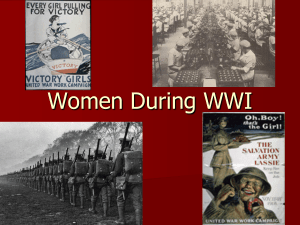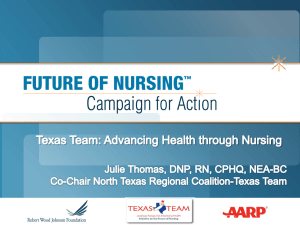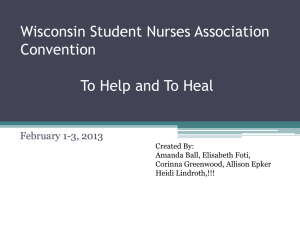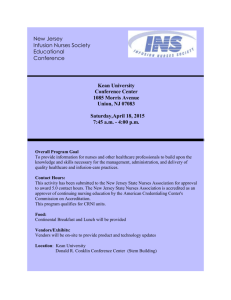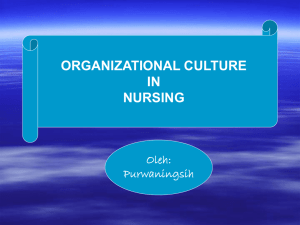slides
advertisement
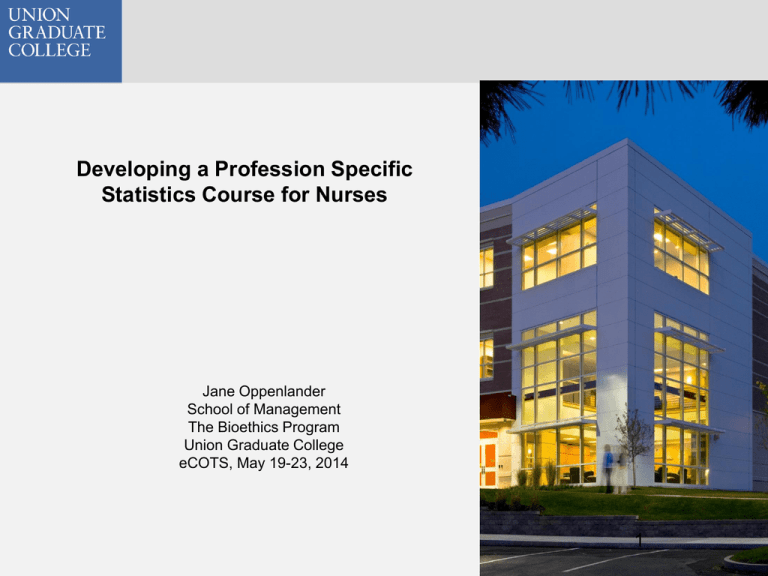
Developing a Profession Specific Statistics Course for Nurses Jane Oppenlander School of Management The Bioethics Program Union Graduate College eCOTS, May 19-23, 2014 1 Evidence-based Nursing Practice • Evidence-based practice (EBP) is an approach to nursing practice that makes use of the best evidence in making clinical decisions about patient care • Steps in the EBP process – Formulate a clinical question – Gather and critically appraise the best evidence – Integrate evidence with clinician expertise, patient condition and preferences and healthcare resources – Evaluate the practice change as a result of implementing the evidence • To meet the needs of practicing nurses, a graduate-level statistics course was designed covering traditional introductory statistics content with a healthy dose of research methodology and biostatistics 2 The Students and Their Motivation • The students were experienced nurses: – – – – Hospital administrators, floor nurses, nursing school faculty Both bachelor’s and master’s prepared in nursing Leading the implementation of evidence-based practice in their institution Some pursuing advanced degrees • The nurses: – Valued the importance and role of statistics and research to achieve efficient healthcare delivery and quality patient care – Were dissatisfied with prior statistics courses, particularly on-line – Lacked confidence in their statistical capabilities – Were motivated to learn and wanted a classroom setting • Matthew et al (2013) report graduate nursing students have significantly poorer attitudes toward statistics than undergraduate nursing and nonnursing majors based on the SATS-36 survey 3 Preparing to Design the Curriculum • Investigate the nursing profession to make course relevant: – – – – – What is important to nurses? To their success? What kinds of problems do they encounter? Where are statistical studies used and needed? Where do they get their data? How and where do they report their findings? • Consulted practicing nurses, nursing professors and researcher, and local healthcare professional organizations • Goal: – Create a graduate level statistics course where nurses can develop competence and confidence in applying statistics to the problems they encounter in their practice 4 Emphasize Statistical Literacy and Thinking • Build statistical literacy by reading, writing and presenting statistical results – Examine abstracts to identify the important and essential statistical concepts – Read and summarize nursing research articles chosen by the students – All student learning assessments are the evaluation of written reports or oral presentations of the type they would be expected to produce in their profession • Statistical thinking is a shift from nurses’ intuition – Collect data from a survey, an operating process, and a design experiment – Evaluate the variability in the collected data graphically and numerically, addressing outlying observations – Examine in detail a published article whose focus is to quantify the variability in the cost of hip replacement (Rosenthal et al, JAMA Internal Medicine, Feb. 11, 2013) 5 Use Real Data • There is an abundance of healthcare data available on the Internet – Federal (data.medicare.gov) and state (e.g., health.data.ny.gov) websites – Hospital acquired conditions are of interest to nurses • Falls, pressure ulcers, certain infections • Data used in the course: – Hospital acquired conditions from regional hospitals for assignments and classroom activities chosen by instructor – Contributed by students from nursing research and quality improvement studies in their hospital – Collected by students for class assignments – Obtained by students from the Internet for final project 6 Stress Conceptual Understanding • Research Process – Types of health studies – cohort, randomized controlled trials – Difference between research and quality improvement studies – Design principles – randomization, blinding, balance – Levels of measurement – Principles and issues survey design • Statistics – Descriptive statistics and effective data presentation – Basics of statistical inference • Hypothesis testing, confidence intervals, p-values, statistical vs. clinical significance – Measure of disease frequency and risk • Odds ratio, relative risk, prevalence, incidence, … – Sample size, power analysis, and effect size – Comparative analysis • 2 sample t-tests, ANOVA, Chi-squared tests of association – Simple regression analysis and correlation 7 Foster Active Learning • Classes are conducted in a workshop fashion – Driven by relevant nursing or healthcare problems – Students frequently work in small groups solving problems and present their results to the class for discussion – Ample time allowed for discussion of how the statistical techniques could be applied in their practice setting • Two of the datasets examined by the class came from students’ nursing practice • Student learning assessments – Focused on either actively producing (and analyzing) data or consuming statistical analysis – In many of the assessments, students choose the problem and data to be addressed, but not the form or length of the written product 8 Use Assessments to Evaluate Learning • • • • • Conduct an at-home experiment Develop and pilot a survey Data collection from a process daily for 30 days Journal article summary in lay language Final project – empirical research project – Problem formulation, literature search, find data, analyze and interpret results – 1 page project proposal, 3 page paper and 15 minute in-class presentation – Students evaluate presentations and provide feedback 9 Use Technology • All software used was chosen because it was available to students in their workplace – Excel with Data Analysis Add-in • Underestimated students’ Excel capabilities. Required preparation of examples, templates, and how-to guides – On-line calculators • Sample size determination • Power analysis • Statistical methods not available through Excel Data Analysis Add-in (www.vassarstats.net) – SurveyMonkey • Audio and Video – 200 countries, 200 years in 4 minutes – NPR All Things Considered segments on health care studies 10 Lessons Learned • Make everything relevant to their profession – Topics covered, cases, problems, and data used • Be willing to learn from your students about their profession as they learn about statistics from you • Working in small groups solving problems was particularly effective • Developing confidence is as important as developing competence to produce workplace advocates for evidence-based practice • Organize material into self-contained modules so it can be reused in professional development settings such as short courses, seminars, etc. • Seek feedback from students periodically throughout the course 11





